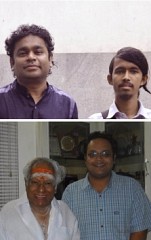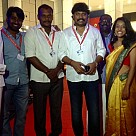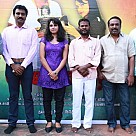PHOTOS & STILLS - GALLERY

“RAHMAN’S RISING STARS” PART 2
In Part 2 of “Rahman’s Rising Stars” Dilani Rabindran chats with Pratap Bhattarai and Dinesh Rahate, students of KM Music Conservatory who have had the pleasure of working and performing with the Oscar winner A.R. Rahman on numerous occasions. As founder of the KMMC in Chennai, Rahman sir is helping to build the future of international arts as he gathers faculty and students from around the world to help preserve and evolve Indian music. Read on to hear surprising insider stories about this humble legend and how KMMC has helped musicians like Dinesh & Pratap expand their knowledge of the universal language of music.
Can you tell me about your musical background and how you joined KMMC?
Pratap Bhattarai: I am from Nepal and 99% of my family have sweet voices but I’m the only one who pursued music! I started learning classical music when I was about 10 years old, but just on the side after school. It was not until after 12th grade that I started learning full time. My maternal uncle wanted me to attend a music course in Katmandu but I was not satisfied with that course, so after that he encouraged me to research schools I would be interested in, even if they were in other countries. So I looked up ones all over India and found the KMMC online. After inquiring about the school and the programme I knew I had a new goal now.
My parents knew that I sing well and that I have the talent, but it was still a big thing and costly jump to India. So it took a while to convince them. Meanwhile I attended college because they wanted me to, even though my focus was always on music, and I continued performing with a band in Nepal. So it took 2 years since I told them I wanted to go for them to agree and I want to say I’m here because of my mother. It was her support that got me here. I actually arrived at the school with my father when the session was already 1 month in, and I had missed the audition period too! But they gave me a shot and asked me why I would want to be a playback singer in India when there are already so many in that field, and I told them, “I want to be a singer who is respected all over the world, and join the range of greats from India."
Dinesh Rahate: I also come from a musical family and my parents always supported my pursuit of music. My path to KMMC actually started when Rahman sir won his Oscars. I had read an article about him and suddenly found out about the conservatory he had started in Chennai. So I got in after applying and joined the foundation course. After that course I started working on my own compositions, and that’s when I got the opportunity to record for Rahman sir, by accident! I was just practicing the drums at school and someone approached me asking if I had a spare egg shaker because someone had taken the one from their room. When I went upstairs to lend them one I found out it was Rahman sir who needed it! He asked me if I would mind playing it for him, so I got to join the recording, and that was for “Cry Cry” from Jhoot Hi Sahi! Then other opportunities started coming along for senior students, like to record this nursery rhyme album with Katrina Kaif, and I sang 2 songs on that. Then I also sang on the Thamizh Anthem.
You have both recorded or performed with Rahman sir a few times. What is working with Rahman sir like?
Dinesh: He is a very caring person. Once we were both singing on the chorus for the “Piya Milenge” for Raanjhanaa, and were waiting for some time because Sukhwinder Singh’s parts were being recorded first. Rahman sir immediately came to ask us upon our arrival if we had eaten dinner and made sure we were well fed because he was worried the recording would run late and we would go hungry. Even another time I remember he was concerned about how we would get home safely late at night. In that way we wouldn’t expect people of his stature to take consideration for us in that way. He is damn sweet.
Pratap: In 2012 when my first course was completed I was a part of one of our KMMC choirs which was specifically used for Rahman sir’s recording purposes. So about 3 to 4 of us from that choir spent all our nights for 6 months recording for him, and it was a great experience. Going to his place to record is a separate feeling; there is a separate aura in Rahman sir’s home studio. Positivity fills the place; it is like a temple for us.
After this period I got a chance to record for Jab Tak Hai Jaan, Kadal and Kochadaiyaan! And I recently sang on a new international song along the lines of “Infinite Love” that is yet to be released.
After this period I got a chance to record for Jab Tak Hai Jaan, Kadal and Kochadaiyaan! And I recently sang on a new international song along the lines of “Infinite Love” that is yet to be released.
What is he like as a teacher from your experiences with him?
Pratap: He loves improvisation and he welcomes suggestions from us! If he can tell you are passionate about something and have put effort he will pay attention to you. That’s the beauty of Rahman sir.
Dinesh: The perfect example of his simplicity is from when he attended our year-end school concert. We were expecting him from 3 pm, and when I went to check on something at the performance area earlier where students were setting up tables, etc. I found Rahman sir there – shifting carpets for us and helping to set up! Can you imagine a guy who has won Grammys and Oscars arranging things for a student concert?
We always think of Rahman sir as a legend and that people should learn from his music, but to me he is the perfect example of both how an artist and a person should be.
You’ve had great opportunities to work with major singers and musicians in the industry. Can you describe one of your favorite experiences that came through KMMC?
You’ve had great opportunities to work with major singers and musicians in the industry. Can you describe one of your favorite experiences that came through KMMC?
Dinesh: Soon after I first recorded with Rahman sir I also got a chance to work on a devotional album with Tamil legend MS Viswanathan! I was actually very new to the South Indian music industry at that time and didn’t have much knowledge of him. I went to borrow a keyboard from my friend saying I had to make a demo for someone and he asked who the music director was so I said “this man named MSV” and my friend exclaimed “Oh God! He’s such a legend!” Only then I knew! That was the first time I ever got the chance to record manually, because nowadays we record everything digitally. And recording like that was a dream of mine that I realized with MSV sir!
Pratap: My favorite opportunity to sing with someone that came through KMMC was the chance to sing with Rahman sir at KM itself! On the day of our 2012 Annual Show we were preparing to perform the national anthem, as was customary, and suddenly I got called by Rahman sir to stand by him. I was confiused and shocked but then even Fatima madam, Rahman sir’s sister, told me to go and then only I realized I wasn’t imagining it!
I am from Nepal, but I’ve always identified with India through its music. And to sing “Jana Gana Mana” standing next to Rahman sir felt like heroism to me.
Can you discuss what different types of world music you have learned since coming to KMMC or how the school’s international connections have helped develop your training?
I am from Nepal, but I’ve always identified with India through its music. And to sing “Jana Gana Mana” standing next to Rahman sir felt like heroism to me.
Can you discuss what different types of world music you have learned since coming to KMMC or how the school’s international connections have helped develop your training?
Pratap: I was actually a metal singer in my hometown! I sang everything from bhajans, to ghazals to hard rock and pop. I even auditioned for the school with “Here Without You” by 3 Doors Down! After coming to Chennai I expanded my knowledge to Western classical music – like that of Mozart and Bach. One of our vocal teachers is from Armenia and from her I have even learned a lot about European folk music.
I personally feel like KMMC stands out in India for the way it teaches Western Classical. Experts from all these different countries gather together to teach us in their own styles. And the faculty teaches us like we are their own children; it is a family atmosphere and feels more like a home than a school. That’s something I think makes it unlike other schools anywhere in the world. We learn about life and music as it exists all around the world, from our teachers, who are from all around the world!
Dinesh: I also used to sing all kinds of styles – sufi, ghazals, patriotic songs, bollywood retros, for example. After coming to KMMC I learned about jazz and the blues, and even gospel! My library has really expanded to all kinds of music with the hits of Pink Floyd, Bryan Adams, Santana, etc. Also, the old managing director of KMMC started an organization called “Global Rhythms” that brought 10-15 students from a music university in New York to India in 2012 and Rahman sir asked me along with a few others to help train them for a few days. We thought it would be quite a challenge for us to teach American students Hindi songs but after just 2 days with them it sounds like Indians singing! In that way KM gave me a chance to explore my teaching talent in an international form, which I did not know I had.
What are you working on right now?
Pratap: Since finishing my preparatory course in 2013 I have remained a part of the school through the KMMC Sufi Ensemble, and now I record jingles, and work on my own albums while touring for performances full time. I am presently working as a composer and singer for a Nepali movie called 72 Hours with Aryan Sekhar and Sailendra Barai. I also recently formed a 6-person band called RAAG, where I am the lead singer and manager, and we are performing all sorts of music all over India in concerts.
Dinesh: I am managing my personal studio with modern equipment where I remix and rearrange old and new songs in different styles. I am also continuing to give performances as part of the KM Sufi Ensemble, with other groups and by myself. I also recently composed the score of a feature length documentary film.
What’s the most important lesson you’ve learned since joining KMMC and starting on this path as a ‘Rahman Rising Star’
Dinesh: From just spending a little bit of time with Rahman sir I have learned that attitude is not needed. You should be down to earth, no matter how big you become, you should maintain the attitude you had when you were still struggling. I remember him getting teary eyed in an interview recalling how in his early days he would spend a lot of money on autos just to earn a few dollars performing where he could. When he got a chance to do a jingle, his mother sold her jewellery so that he could arrange for some studio time to record, and to this day, despite how far he has come, he still remembers those times and appreciates the value of that struggle.
Pratap: Once we had a meeting with Rahman sir and he asked us “What do you think is the most important thing in life?” And he told us “the main thing is love. Do whatever you want to do, just do it with love and you will get somewhere.” Those golden words are his best lesson. I always tell people “the person who can talk can sing and the person who can walk can dance. You just have to love what you do and do it with passion”, and I learned that from Rahman sir. Lessons like this is why I am very proud to be a student of his.
I never identify myself as a singer or a musician first, I first announce that I am a student of KMMC and a student of A.R. Rahman.
Respond to dilani@behindwoods.com
Behindwoods is not responsible for the views of columnists.
Behindwoods is not responsible for the views of columnists.
FACEBOOK COMMENTS
OTHER LATEST COLUMNS
DILANI RABINDRAN'S OTHER COLUMNS
- The First Hero I Knew
- “Rahman’s Rising Stars” Part 1
- That Altruistic Masala Action
- Jigarthanda: Lessons in Filmmaking
- VIP and the Forms of Dhanush!
- That Inexplicable Rajini Effect
- The King’s Decree
- The Year of Her(s)
- The Rahmaniac Syllabus
- Do you know who Rajinikanth is?
- Ajith - Making Bad look so Good
- Raja Rani and the Cinematic Couples Therapy
- Behindwoods at TIFF - Days 8 -11
- Behindwoods at TIFF – Days 5 to 7
- Behindwoods at TIFF – Days 1 – 4
- Will he or won't he - Vijay and the guessing game
- "A Gun & A Ring" and a Director to Watch For
- Thala - Using his status to lead !
- Rapid Fire with Vidyu Raman
- "Funny Girl" – An Interview with Vidyu Raman
- The Man + The Maker Part 2
- The Man & The Maker (Part 1)
- "Festivals of Film &Globalization"
- "Using Film for Societal Change"
- 15 Years of Jeans
- "How the South Shapes Bollywood"
- "A Marriage of Film and TV"
- Women in Real and Reel Life
- Hitting the Jackpot Twice
- VISHWAROOPAM: A Lesson in Crisis Communications
- "Education Through the Silver Screen"
- From Maddy to Gautham - The Valentine's Day Spread
- Vishwaroopam: A first hand account from across Atlantic!
RELATED LINKS
- Vikram is my best friend- Says Ilayathalapathy Vijay !
- Drums Sivamani Wedding
- Lingaa - Mona Gasolina Promo Song
- Lingaa Hindi Trailer
- Ameeta
- “That was an unbelievable feeling to realise we were going to create a Rahman musical” - Sashikanth
- “Rahman’s Rising Stars” Part 1
- Lingaa Teaser
- Kaaviya Thalaivan Trailer
- Raunaq - Laadli song
- For those who missed the 'I' audio launch
- Pookalae satru oyivedungal- Song review
- Ennodu nee irundhal- Song review
- I Teaser
- Muthalvan choose something else to bathe! | Vijay, Ajith, Suriya and Vikram's version of Ice Bucket Challenges ! - Slideshow
ABOUT THIS PAGE
This page hosts the views of the authors of the column. The views are generally about films, movie reviews, movie news, songs, music, film actors and actresses, directors, producers, cinematographers, music directors, and all others that contribute for the success or failure of a film. People looking for movies online, movie reviews, movie analysis, public response for a movie, will find this page useful.











